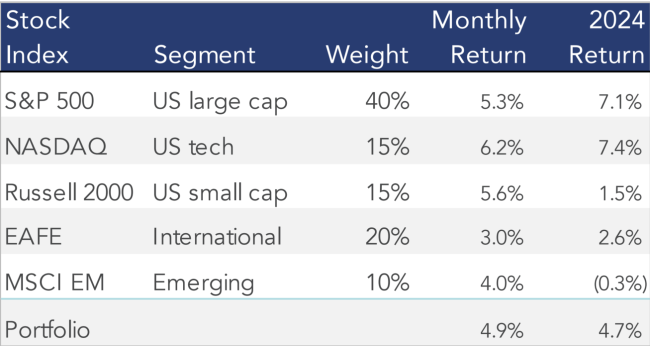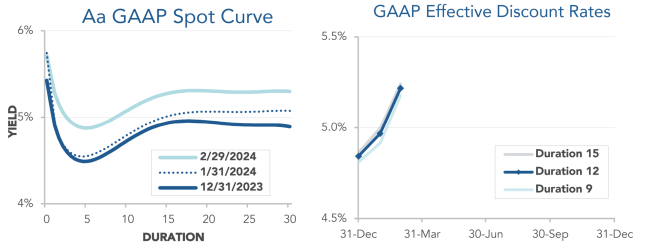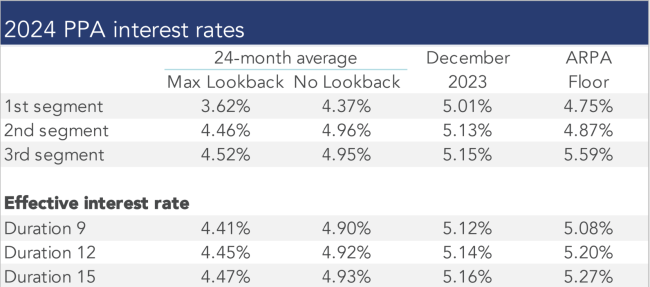Pension Finance Update February 2024
After a quiet January, pensions enjoyed a strong month in February, as higher interest rates accompanied higher stock markets. Both model plans we track[1] gained ground last month: traditional Plan A improved 5% and the more conservative Plan B gained more than 1% during February:
[1] Plan A is a traditional plan (duration 12 at 5.5%) with a 60/40 asset allocation, while Plan B is a largely retired plan (duration 9 at 5.5%) with a 20/80 allocation with a greater emphasis on corporate and long-duration bonds. We assume overhead expenses of 1% of plan assets per year, and we assume the plans are 100% funded at the beginning of the year and ignore benefit accruals, contributions, and benefit payments in order to isolate the financial performance of plan assets versus liabilities.

Assets
Stocks enjoyed strong growth across the board in February. A diversified stock portfolio ended the month up almost 5% so far this year:

Interest rates moved up more than 0.2% last month and are now up 0.3% for the year. As a result, bonds ended February down 2%-4% so far this year, with long duration bonds performing worst.
Overall, our traditional 60/40 portfolio ended the month up 2% so far this year, while the conservative 20/80 portfolio was down 1% through the first two months of 2024.
Liabilities
Pension liabilities (for funding, accounting, and de-risking purposes) are driven by market interest rates. The first graph below compares our Aa GAAP spot yield curve at December 31, 2023 and February 29, 2024 (along with the movement in the curve last month). The second graph below shows our estimate of movements in effective GAAP discount rates for pension obligations of various duration during 2024:

Corporate bond yields rose 0.25% in February and are up 0.35% so far this year. As a result, pension liabilities have declined 2%-4% through the first two months of 2024, with long duration plans seeing the largest drops.
Summary
In its simplest form, pension finance boils down to stocks vs. bonds, and over the past five years, stocks have produced strong returns while bonds have not, which translates to improved pension finances. Early in 2024, that trend continues to hold. The graphs below show the movement of assets and liabilities during the first two months of 2024:

Looking Ahead
Pension funding relief was signed into law during March of 2021, and additional relief was provided by November 2021 legislation. The new laws substantially relaxed funding requirements over the next several years, but the increase in rates seen in the past year has significantly eroded the impact of relief in 2023 and 2024.
Discount rates moved more than 0.2% higher last month. We expect most pension sponsors will use effective discount rates in the 5.1%-5.4% range to measure pension liabilities right now.
The table below summarizes rates that calendar-year plan sponsors are required to use for IRS funding purposes for 2024, along with estimates for 2025. Pre-relief, both 24-month averages and December ‘spot’ rates, which are still required for some calculations, are also included.


